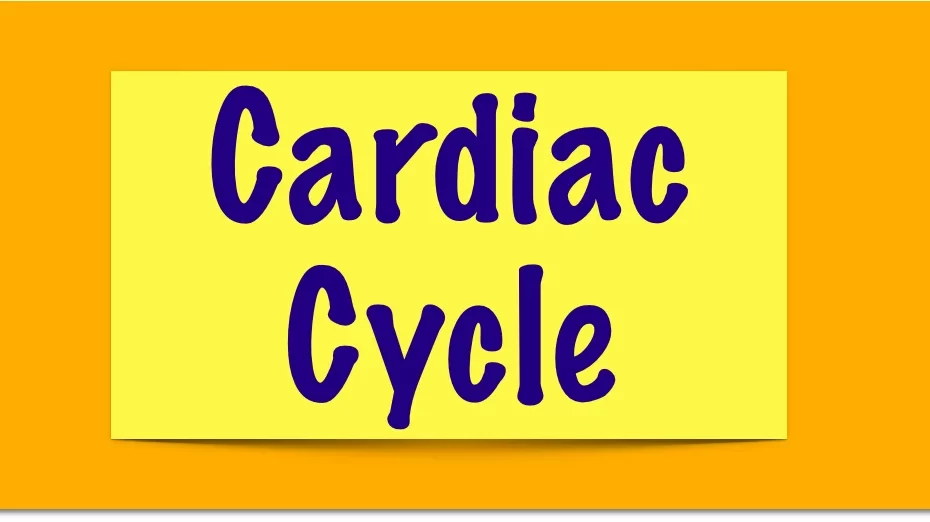We have discussed about the cardiac cycle.
- Definition of cardiac cycle
- Phases/Steps of cardiac cycle – Systole and Diastole
- Understanding the graph cardiac cycle
Definition of cardiac cycle :
This is a cycle which represents all the events which takes place inside the heart during one complete blood circulation.
When blood enters into the Right atrium from vena cavae and in left atrium from Pulmonary vein, and then by Ventricular diastole , blood from both atria comes into the ventricles. Then The bloods goes into their own destination by ventricular contraction, like blood from right ventricle goes into Pulmonary artery and blood from left ventricle goes into Aorta. Through this process circulation inside the heart goes on.
Cardiac cycle phases/steps with duration :

There are mainly two broad phase of cardiac cycle and they are – Systole and Diastole. Systole can be divided into Atrial systole and ventricular systole whereas Diastole can be also divided into Atrial diastole and Ventricular diastole.
In clinical medicine we mainly keep Systole as ventricular systole and Diastole as ventricular diastole, and we avoid Atrial systole and Atrial diastole. In the graph of cardiac cycle you will see ‘Atrial Systole’, but that is not included in the main broad systole and diastole part.

A. Steps/Phases of Systole :
As we have talked earlier that in clinical medicine we understand Systole as ventricular systole. So these two events which occurring are of ventricles. Ventricular Systole is about 0.27 second .
I. Isovolumetric Contraction phase :
This is the first phase in of cardiac cycle in which contraction of ventricular muscle gets starts. And the duration of this phase is about 0.05 second. Due to a rise in ventricular pressure, the atrioventricular valves closed immediately after atrial systole.
And the semilunar valve is already closed up to this point. Ventricles now contract as closed cavities, with no change in the capacity of the ventricular chambers or the length of the muscle fibres. Only the ventricular musculature’s tension rises.
During isometric contraction, the pressure inside the ventricles rises dramatically due to increased tension in the ventricular musculature.
Due to closure of AV valves, the formation of 1st Heart Sound occurs.
II. Ejection phase :
This phase lasts for about 0.22 second. Blood is expelled from both ventricles due to the opening of semilunar valves and isotonic contraction of the ventricles. As a result, this phase is known as the ejection period.
This phase has two sub phases and they are :
- Rapid ejection period and this lasts for about 0.13 second.
- Slow ejection period and this lasts for about 0.09 second.
B. Phases/Steps of Diastole :
Ventricular Diastole is about 0.53 second.
I. Protodiastole phase :
There is an event which is occurring before the Isovolumetric relaxation event, and that is Protodiastole. Which lasts for about 0.04 second.
Due to closure of Semilunar valves(Aortic valve and Pulmonary valve), the formation of 2nd Heart Sound occurs.
II. Isovolumetric relaxation phase :
This phase lasts for about 0.08 second.
The pressure in the aorta and pulmonary artery rises as blood is ejected, while the pressure in the ventricles falls. The semilunar valves close when intraventricular pressure falls below the pressure of the aorta and pulmonary artery. The valves of the atrioventricular system are already closed.
III. Rapid Inflow phase :
This phase lasts for about 0.11 second and this event results in filling of ventricles by 70% of blood in diastole phase. When the AV valves are opened, blood rushes from the atria into the ventricles.
Due to rapid inflow of blood, here 3rd heart sound is formed sometimes.
IV. Diastasis phase:
This phase lasts for about 0.19 second and this results in filling of blood by 20% of diastolic phase.
V. Last Rapid inflow phase :
Remaining 10% of blood is filled in this phase and the duration of this phase is about 0.11 second.
Understanding the graph of cardiac cycle :

Understanding the cardiac cycle is easy but with all the events simultaneously, it becomes difficult. In higher study one have to be clear about all the events in simultaneous manner. This graph simply represents all the cardiac events occurring during one cardiac cycle. If you are able to understand this graph then Cardiac cycle will be in your daily imagination life.
Now in this graph you are getting mainly 4 curves which represents – Aortic pressure, Ventricular pressure, Atrial pressure and Ventricular volume. But to understand the graph we have to start with a sequence ; first take Atrial pressure, then Ventricular volume, after that ventricular pressure and last Aortic pressure.
Cardiac graph explanation :
When atrial systole starts the pressure inside the Atrium starts to increase which helps to eject some remaining blood. So in few milliseconds it agains starts to drop and again starts to rise when AV-closes. Av valve closes because of ventricular contraction which will help to prevent the back flow of blood into the atria.
Now the increasing of pressure lets the Av valve to open and Ventricular diastole starts. Negative pressure which is formed inside the heart pulls back blood from Atria.
Now apply the P∝1/V ; if you apply then you will able to see that the ventricular volume curve is also rising. By this way Atrial pressure curve and ventricular volume curve corelates with each other.
And when atrial systole occurs remaining blood will enter the ventricles, which will cause formation of another rise in the curve.
Now come to Ventricular pressure, where you will see that increase in ventricular pressure causing decrease in ventricular volume, because of Systole stage.
Aortic pressure will increase when there will be blood filling in the Aorta, this occurs when left ventricle contracts and blood goes into the Aorta. So aortic pressure will also increase with Ventricular pressure.
